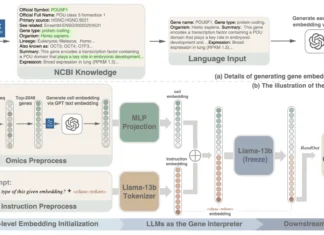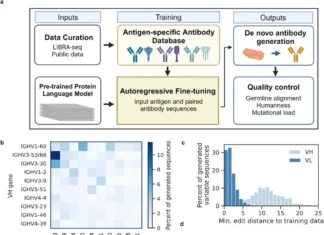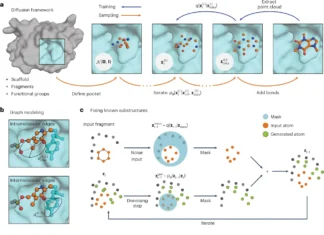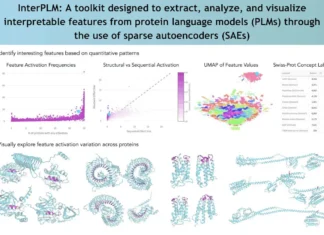How Evolla is Deciphering the Molecular Language of Proteins with an...
The complex molecular machinery that make up nature, proteins have evolved over billions of years and are essential to the continuation of life. However,...
University of Washington Researchers Revolutionize Beta-Barrel and Transmembrane Nanopore Design Using...
A team of researchers from the University of Washington has made significant strides in protein design by addressing long-standing challenges in creating beta-barrel structures....
USC Researchers Unveil METAGENE-1: Advancing Pathogen Detection and Pandemic Monitoring
In the ever-evolving world of infectious diseases, early detection and monitoring play a critical role in combating pandemics. In a groundbreaking collaboration, researchers from...
10 Days Hands-on Skill Development Training Program on R for Bioinformatics...
R is a powerful and versatile programming language widely used in biological data analysis for its robust statistical capabilities and extensive library of tools...
Generating Hit-Like Molecules with Gx2Mol: A Deep Dive into Gene Expression...
Even though SMILES and molecular graphs have been used in earlier research, drug reactions in biological systems, such as genes and proteins, are frequently...
MIT Scientists Develop More Precise Computational Method for Predicting Antibody Structures
Antibodies, the sentinels of our immune system, are masters of adaptability. Their ability to bind to an almost infinite range of pathogens lies in...
Human Metapneumovirus (HMPV): A Hidden Respiratory Threat or Just Another Cold...
Human Metapneumovirus (HMPV) is a respiratory virus that has recently gained prominence in public health discussions, particularly due to outbreaks in various regions, including...
Scaling Structure-Based Molecular Design with ECloudGen’s Electron Cloud Approach
In a groundbreaking step toward more effective molecular design, researchers from Zhejiang University and others have introduced ECloudGen, a cutting-edge framework that integrates quantum...
RNAGenesis: A Foundation Model Advancing RNA Sequence Generation and Structural Insights
Many biological processes depend on RNA engineering, which advances the knowledge of life's mechanisms and propels the discovery of new drugs. New strategies are...
How SCREADER Uses Large Language Models to Decode scRNA-seq Data
In a groundbreaking study by researchers at the Harbin Institute of Technology, a novel approach to interpreting single-cell RNA sequencing (scRNA-seq) data has emerged....
MIT Unveils Boltz-1: An Open-Source Tool for Biomolecular Structure Prediction
Developing an understanding of biomolecular interactions is essential for developing domains such as protein design and drug development. The open-source deep learning model Boltz-1,...
Top 10 Bioinformatics Breakthroughs of 2024!
In 2024, bioinformatics has once again proven to be a cornerstone of innovation, driving discoveries that are reshaping our understanding of life at a...
AI-Powered SciAgents: Redefining Research in Complex and Interdisciplinary Scientific Domains
In this work, researchers from MIT present an AI invention called SciAgents that solves hidden interdisciplinarity connections that were originally seen as distinct. The...
Aging Reimagined: The Power of Metabolomics and Machine Learning
A groundbreaking study conducted by researchers at the UK Biobank has unveiled a novel approach to understanding aging through metabolomics and machine learning. This...
Large Language Models Redefine Antigen-Specific Antibody Design
Machine learning and artificial intelligence (AI), two recent developments in computational biology, have demonstrated important capabilities and benefits above conventional approaches. AI-based techniques have...
Top 5 AI Trends Bioinformaticians Need to Know in 2025
As we approach 2025, the integration of artificial intelligence (AI) into bioinformatics is set to transform the field dramatically. Bioinformaticians must stay abreast of...
Building the Virtual Cell: AI’s Next Frontier in Biology
Artificial Intelligence-powered Virtual Cells (AIVCs) are an exciting new cell-equivalent system. As the name states, AIVCs utilize complex algorithms of artificial intelligence to simulate...
Predicting Protein Dynamics with BioEmu: A New Frontier in Biomolecular Research
A major field of study is the scientific problem of predicting dynamical mechanisms in proteins after structural revolutions, with molecular dynamics simulations offering important...
How Does NeuralPLexer3 Combine Physics and Machine Learning for Superior Biomolecular...
The quest to understand biomolecular interactions is central to advancing drug discovery, molecular biology, and bioengineering. A significant step in this journey is accurately...
FedPyDESeq2: Advancing Differential Expression Analysis with Federated Learning for Bulk RNA-Seq
In genomics, the conventional approach for explaining any gene expression is to cross-analyze bulk RNA sequencing (RNA-seq) data. However, as researchers, more often than...
Decoding Protein Roles with ProCyon: A Unified Framework for Multiscale Phenotypes
About 20% of human proteins lack recognized functionalities, and over 40% lack context-specific functionals, underscoring the difficulties of comprehending these proteins and their varied...
Streamlining Copy Number Variation Discovery: How CNV-Finder is Changing Genomics
A prevailing challenge in genomics still revolves around the comprehension of structural variants, one of which is copy number variation (CNV). To undertake the...
Unlocking Protein Design with PLAID: A Sequence-Centric Generative Model for All-Atom...
The potential influence of generative models for protein design is drawing the attention of the scientific world. However, there are numerous modalities that mediate...
The Nucleotide Transformer: How Foundation Models are Shaping Human Genomics
The field of genomics is ever-changing as a result of an increase in automation and aspects of biological engineering. A groundbreaking study led by...
Protein Language Visualizer: A New Era of Sequence Similarity Exploration
The availability of biological "big data" and the development of high-throughput sequencing technology have sped up the identification of new protein sequences, making it...
Unlocking the Potential of Equivariant Diffusion Models for Structure-Based Drug Design...
In the quest to create better and faster methods for drug discovery, a team of innovative researchers from various institutions has developed a groundbreaking...
Harnessing AI for Molecular Discovery: The Promise of Molecular Dynamics Language...
Although molecular dynamics (MD) simulations provide accurate representations of the motion of molecular systems, molecular biology and materials science are challenged by the computational...
Decoding the Genetic Mechanism of B Chromosome Drive in Rye
The extra genetic material, which appears as 'B chromosomes,' has been a riddle for security for many species. They are of least concern for...
Streamlining High-Throughput Protein Complex Modeling with AlphaPulldown2
AlphaPulldown version 2.0, a noteworthy computational biology program that transforms protein structure modeling, is presented by researchers from the European Molecular Biology Laboratory, Hamburg,...
The G2PT Model: Bridging the Gap Between Genotype and Phenotype Using...
Gaining insight into the peculiar relationship between the genes we possess and the characteristics they express is undoubtedly one of the most intriguing quests...
Evolutionary Scale’s ESM Cambrian: Revolutionizing Protein Understanding at the Scale of...
Proteins are the most essential molecules for all forms of life on Earth. They perform a vast number of actions vital for life. However,...
DRUG-seq: A Game-Changing Approach to Transcriptional Profiling in Drug Discovery
The identification and comprehension of the mechanisms of potential drug compounds is a complex and expensive endeavor in the constantly changing pharmaceutical research landscape....
AI-Driven Macrocycle Design: How RFpeptides Generate High-Affinity Protein Binders for Diagnostics...
Large-scale screening techniques that are resource-intensive and offer limited control on binding mode are usually used to produce macrocyclic binders to therapeutic proteins. There...
Can InterPLM Decode the Hidden Language of Protein Modeling and Design...
The emergence of Protein Language Models (PLMs) is changing biological research for the better through efficient prediction of functional annotations and protein structures. However,...
Learning from Extremophiles: HyperMPNN’s Revolutionary Approach to Thermostable Protein Design
Recombinant proteins must be stable in order to be used in biotechnological or medicinal applications. Both the creation of new proteins and the stabilization...
Unlocking the Power of Single-cell RNA Sequencing with scExplorer
With its recent advancements, scRNA sequencing has enabled scientists to view the biological world at the most local of levels- the single cell. Thanks...
Seamless Multi-Omics Integration Made Easy with iModMix
Integrating metabolomics with other omics and providing insights into the biology of disease requires bioinformatics competence. Integration is difficult with present approaches, though, as...
Unlocking Chemical Space: TamGen’s Generative AI Approach for Target-Aware Molecule Generation...
Novel compounds can be discovered in the wide chemical space due to generative drug design that enables one to develop molecules that are effective...
Exploring New Frontiers in SARS-CoV-2 Research with The Virtual Lab
When COVID-19 emerged as a global catastrophe, the scientists had only one goal: to come up with the possible treatments for the virus SARS-CoV-2,...
RhoFold+: Transforming RNA 3D Structure Prediction with Deep Learning
Although RNA 3D structures are important in understanding their functions and in the design of new drugs, their accurate prediction is still a challenge....
Unlocking the Secrets of RNA: How RNA-GPT is Transforming the Way...
RNAs are crucial molecules that convey genetic information necessary for life, and they have a big impact on biotechnology and medicine development. However, the...
From Concept to Reality: Efficient Protein Pocket Design with PocketGen
Protein pockets have been an integral part of drug discovery for several years and are also targeted during the design of novel molecules. Pockets...
Evo: A Genomics Foundation Model Redefining Sequence Modeling and Design
The DNA sequences of all living organisms hold the fundamental instructions for life. Massive datasets of entire genomes, together with machine learning advancements, may...
Innovating Through Collaboration: The Protein Engineering Tournament’s Impact on Computational Design
Protein engineering heavily relies on generating sequences using computational models. Limitations such as lack of benchmarking opportunities, scarcity of large protein function datasets, and...
How BALM is Redefining Binding Affinity Prediction for Unseen Targets and...
In the fast-paced world of drug discovery, one of the most crucial aspects is understanding protein-ligand interactions. With the correct algorithms for predicting protein-ligand...
EPBDxDNABERT-2: A Multi-Modal Deep Learning Model for Enhanced Transcription Factor DNA...
It has been demonstrated that there is a functional correlation between transcriptional activity, thermodynamic stability, DNA breathing, and transcription factor (TF) binds. The researchers...
Omega-3 and Omega-6 Fatty Acids: New Allies in Cancer Prevention
A groundbreaking new research from the University of Georgia unveils that omega-3 and omega-6 fatty acids may play an integral role in cancer prevention,...
The Future of Bioinformatics: Building Expertise for Data-Driven Discovery
In an era where biological data grows exponentially, bioinformatics has emerged as a vital interdisciplinary field that combines biology, computer science, mathematics, and statistics....
The Power of Foundation Models in Pathology: How Paige’s Virchow is...
Computational pathology is the evolution of cancer diagnosis into a new era, with the application of artificial intelligence to understand complex histopathology images. Generally,...
Unlock Molecular Conformations with Moltiverse Using Enhanced Sampling Molecular Dynamics Simulations
For drug development to be effective, it is essential to accurately predict the various bound-state conformations of small compounds, especially in situations where intricate...























































